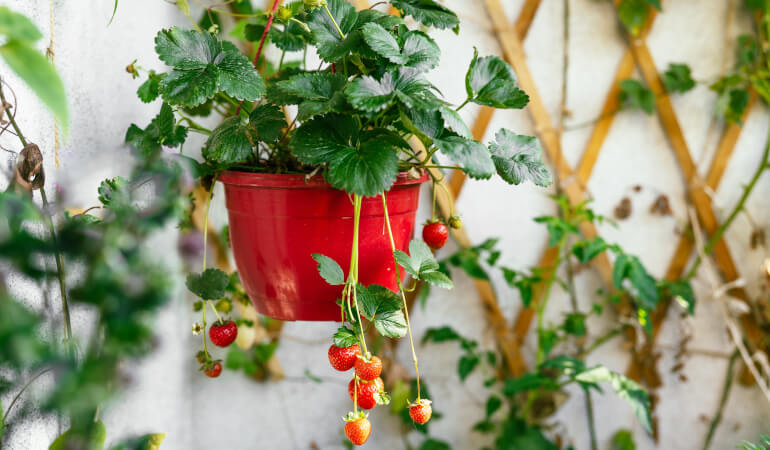
Nowadays, lots of people grow strawberries at home. Flat balconies, tiny patios, even sunny windowsills indoors, you name it. With strawberries, almost everything works and you don’t need to be a professional gardener either.
This post shows you how to grow strawberries in pots the easy way. If you’ve got a pot, a bit of soil, and some sun, you’re all set. Let’s get started.
Table of Contents
Select the right strawberry variety to grow
In general, strawberries do grow well in pots, but there are some considerations. Some send out too many runners, while others need deep soil to grow well. Here are a few good picks for growing strawberries for beginners:
- Mignonette – Small , sweet and great for snacking. Also looks pretty, so it works well in a pot on the patio;
- Mara des Bois – A French type with rich taste and amazing smell. It keeps giving fruit for months;
- Albion – It gives Bigger berries, a decent crop, and does well in pots. Likes the sun and keeps fruiting for longer;
- Flamenco – Tasty, tidy and easy to handle, it’s great for hanging baskets;
- Hapil– Juicy and soft. Gives a big harvest, but needs a bit more space than others.
When you choose a variety, consider a few things:
- Climate – Pick one that suits your area. Some strawberry varieties hate too much rain or cold;
- Growth habits – Some grow upright, while others send out runners. For pots, go for compact ones;
- Taste – Do you want sweet, sharp, or rich flavour?
- Crop size – Some give loads of fruit. Others just a bit, but nicer;
- Look – Want them to look pretty too? Go for ones with neat leaves and flowers.
Find the perfect containers
First of all, what is the best container for growing strawberries? One that drains well and gives the roots enough room. Sounds simple, but not every pot does the job.
So, go for a container that’s at least 20–25cm deep as that gives the roots space to grow. Each plant needs a bit of breathing room, so avoid packing them in too tight. Now let’s talk about the types.
- Plastic pots – Cheap, light, and easy to move. These hold water better but may heat up fast in the sun;
- Clay pots – they look nice and let the roots breathe, but they dry out quicker. You’ll need to water more;
- Wooden crates – Great for a rustic look, but keep them raised off the ground to stop rot;
- Hanging baskets – Good if you’re short on ground space, so hang them somewhere sunny, even indoors by a window if you have enough light;
- Stacking pots – Each layer holds a few plants, and you can build them up like a tower. Great for patios or small gardens. Just make sure the top plants don’t block the sun from the ones below.
- Tiered planters – Look great on patios. If you’re into growing strawberries in pots vertically, or curious how to grow strawberries in tiered pots, these are your friends. You get loads of fruit without needing loads of room.
No matter what you pick though, make sure the pot has drainage holes. Strawberries hate soggy roots and waterlogging can rot the plant fast. Put a saucer or tray underneath, but never let it fill up with standing water. By the way that advice goes if you decide to grow potatoes in pots as well.
Get the soil ready for planting
Strawberries need the right mix to grow well in pots. The roots like soil that’s light, rich, and drains fast. On the other hand, heavy or soggy compost holds too much water and can rot the plant.
So, what soil do you need to grow strawberries in pots? A good multi-purpose compost works fine. If it feels too heavy, mix in a bit of perlite or sharp sand. That helps with drainage and gives the roots some air.
You can also add organic matter like worm castings or rotted manure. That boosts the nutrients and helps hold just the right amount of moisture. Don’t pack the soil down too tightly. Instead, keep it loose so roots can spread.
Planting and watering
The best time to plant strawberries in UK is from March to May. By then, the frost has passed. That’s when the soil starts to warm up and plants get a good head start. In colder zones, you should wait a bit longer. If you live somewhere mild, you can start a bit earlier.
And what about when to sow strawberry seeds? Late winter to early spring is best. Keep them warm and bright indoors until they’re ready to move. Perhaps even make a planning calendar.
And now when you know when, here is how to plant the strawberries in containers:
- Get the pot ready – Add a layer of gravel or broken bits at the bottom if you like. Then fill it with fresh, well-draining compost;
- Set the plants at the right depth – Place each strawberry plant so the crown sits just above the soil. Don’t bury it. Cover the roots with compost and press gently to keep the plant steady;
- Space the plants properly – In a 30cm pot, plant two or three strawberries. For long planters, space them 20–25cm apart. This gives the roots room to grow and helps air flow between plants;
- Water well after planting – Soak the soil so it settles around the roots;
- Keep an eye on moisture – In warm, sunny weather, water once a day. In cooler or cloudy conditions, every two to three days should be enough. Always check the top few centimetres of soil before watering. If it’s dry, water. If it’s damp, leave it.
- Add mulch if needed – Once the plants settle, you can add a layer of straw or fine gravel around the base. This keeps fruit clean and helps the soil stay moist for longer.
How long do strawberries take to grow in pots?
If you start from seeds, you’ll wait about 3 to 6 months before you see fruit. With young plants or runners, you’ll usually get berries in the first summer. Sometimes within 6 to 8 weeks even if they’re strong and the weather’s right.
Care tips for strawberries
Strawberry plant care is simple once you know what to watch for.
Watering
Check the top 2cm of soil with your finger. If it’s dry, it’s time to water. In warm weather, water every day. On cooler days, go every 2–3 days. If you overwater, you will see yellow leaves and soft, limp stems. Underwatering, on the other hand, makes leaves droop or go crispy.
Feeding
What to feed strawberry plants? Use a balanced liquid fertiliser every 10–14 days once flowers show. That helps grow more fruit. You can use tomato feed, also.
Mulching
Lay straw or fine gravel around the base of each plant. This keeps fruit clean and helps stop water from evaporating too fast. It also keeps slugs off the berries.
Pruning runners
Snip off runners, unless you want to grow new plants. Why prune them? Because runners drain energy. When you cut them your plant puts more effort into growing fruit instead of spreading out.
Sunlight
Give your strawberry plants at least 6 hours of sun a day. Also, provide them with the best spot in a south or west-facing area. If you’re growing strawberries in a greenhouse, watch the heat. Ventilate on hot days so they don’t fry.
The British climate can be a bit much at times with its wind, rain, and cold. Keep pots sheltered from strong gusts, lift them off the ground during heavy rain, and cover them with fleece or bring them indoors during frosts. That’s the easiest way to winterise strawberry plants in pots and keep them going strong.
There is also something to be said about pests. Even in pots, strawberries can attract…
- Slugs – These love damp compost and ripe fruit. Try copper tape around the pot or a layer of sharp gravel to keep them away;
- Aphids – Small green or black bugs that suck sap from the leaves. You might spot curled or sticky leaves. Spray with soapy water or use an organic insect spray to shift them;
- Vine weevils – These are sneaky. Adult beetles nibble leaves, but the real problem is the white grubs in the compost. If your plant suddenly wilts, check the roots. Nematodes (tiny beneficial worms) can help, or swap out the old compost;
- Powdery mildew – Looks like a white dust on the leaves. It shows up in warm, stuffy conditions. Keep plants spaced out, avoid wetting the leaves when you water, and pick off any infected bits;
- Birds – Once berries start to ripen, birds will try their luck. Cover your pots with netting to stop them from pinching your fruit.
Bonus tips for bigger and longer yields
Once your plants settle in, there are a few easy tricks to get more fruit for longer. Try hanging baskets to save space and lift fruit away from pests. Stagger your varieties. Some crop early, others later. That way, you get berries for longer.
Also, deadhead flowers that don’t form fruit and keep trimming runners. Replace plants every 3 years. Older ones slow down and give less fruit.
Harvest and enjoy your home-grown strawberries
When do strawberries fruit? In the UK, most types start cropping from late May to July. Some keep going into early autumn, but that depends on the variety.
You’ll know it’s time to pick when the berries turn deep red all over. They should feel soft but not mushy. If you’re unsure, taste one. If it’s sweet and juicy, it’s ready.
There also comes the question of how to pick the plant without damaging it. Don’t yank the berry off. That can tear the stem or hurt the plant. Instead, pinch the stalk just above the fruit. Or snip it with small scissors.
As far as storage goes, store strawberries in the fridge to keep them fresh for 2-3 days. Don’t wash until ready to eat. You can also freeze or use in jams, smoothies, cakes, and salads.
What to do with strawberry plants at the end of the season?
Once the harvest is over, give your plants a good clean. Snip off old leaves and runners to encourage fresh growth and stop disease from settling in. Give the plant a light feed to help it store energy for next year.
Check the roots and compost. If the plant looks tired or the soil feels compacted, it’s worth to repot or refresh the mix. To protect that plants over winter, leave the pots outside but move it to a sheltered spot.
In colder areas, use fleece or a cold frame to keep the worst of the frost off. That’s how you winterise strawberry plants in containers and get them ready for the next season.
Everything grows better in a tidy garden. Schedule your garden maintenance now!
Enter your postcode to view our rates and availability in your area.
For questions about the services we offer visit our main site
Takeaways
- Pick pot-friendly strawberries, because not all of them like to be in pots;
- Use deep, well-draining pots of at least 20–25cm depth;
- Keep the soil loose so roots can spread easily;
- In the UK, plant from March to May because by then, the frost should have passed;
- Pick the berries when they’re fully red and snip gently to avoid damage.



